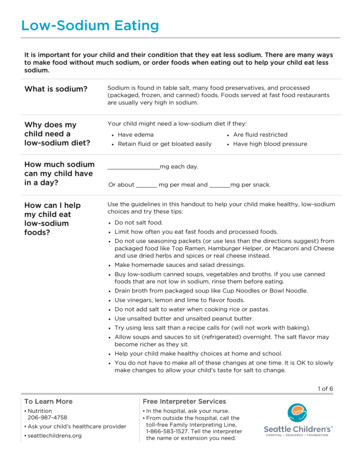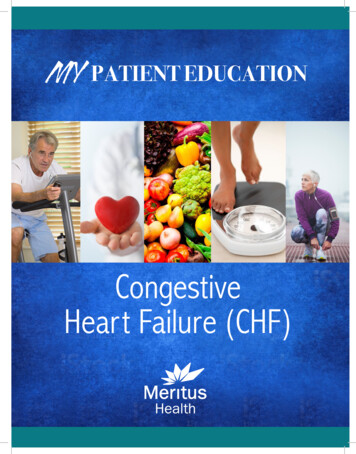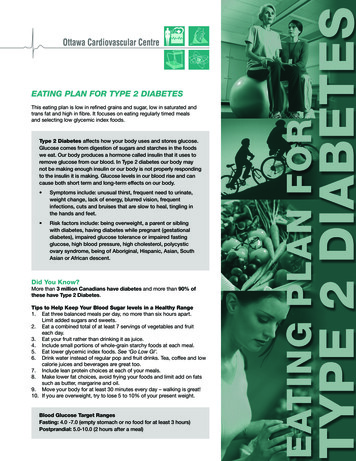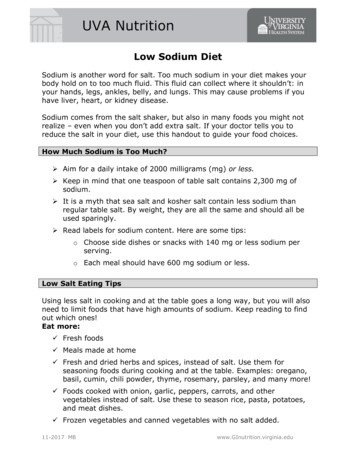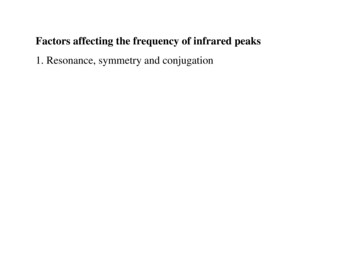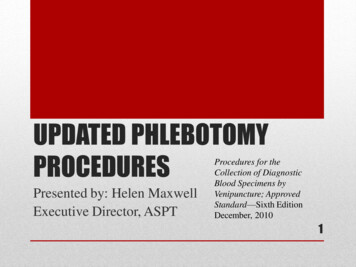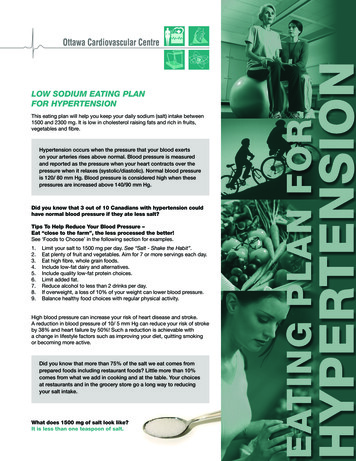
Transcription
LOW SODIUM EATING PLANFOR HYPERTENSIONThis eating plan will help you keep your daily sodium (salt) intake between1500 and 2300 mg. It is low in cholesterol raising fats and rich in fruits,vegetables and fibre.Hypertension occurs when the pressure that your blood exertson your arteries rises above normal. Blood pressure is measuredand reported as the pressure when your heart contracts over thepressure when it relaxes (systolic/diastolic). Normal blood pressureis 120/ 80 mm Hg. Blood pressure is considered high when thesepressures are increased above 140/90 mm Hg.Did you know that 3 out of 10 Canadians with hypertension couldhave normal blood pressure if they ate less salt?Tips To Help Reduce Your Blood Pressure –Eat “close to the farm”, the less processed the better!See ‘Foods to Choose’ in the following section for examples.1.2.3.4.5.6.7.8.9.Limit your salt to 1500 mg per day. See “Salt - Shake the Habit”.Eat plenty of fruit and vegetables. Aim for 7 or more servings each day.Eat high fibre, whole grain foods.Include low-fat dairy and alternatives.Include quality low-fat protein choices.Limit added fat.Reduce alcohol to less than 2 drinks per day.If overweight, a loss of 10% of your weight can lower blood pressure.Balance healthy food choices with regular physical activity.High blood pressure can increase your risk of heart disease and stroke.A reduction in blood pressure of 10/ 5 mm Hg can reduce your risk of strokeby 38% and heart failure by 50%! Such a reduction is achievable witha change in lifestyle factors such as improving your diet, quitting smokingor becoming more active.Did you know that more than 75% of the salt we eat comes fromprepared foods including restaurant foods? Little more than 10%comes from what we add in cooking and at the table. Your choicesat restaurants and in the grocery store go a long way to reducingyour salt intake.What does 1500 mg of salt look like?It is less than one teaspoon of salt.
Tips to reduce salt (sodium) intake Home prepared fresh or frozen foods are best. If usingcanned foods, look for labels such as “no added salt”or “low sodium”.Avoid adding salt to your food and omit from recipes wherepossible.Season your food with herb and spice blends. see recipeto the right. Check ingredient lists to avoid those with salt.Limit condiments such as ketchup, mustard, soy sauce etc.Use ingredient lists - foods listing salt or sodium at thebeginning of the list or multiple times in the list are high in salt.Restaurant foods are often high in sodium. Try to avoid fastfood but do use the restaurants’ Nutrition Information toidentify lower sodium options. When eating out, ask yourserver if the meal can be prepared without added salt.Request sauces on the side.Homemade Herb BlendThis multi-purpose salt free seasoning can replace thesalt in your table top shaker and is great in casseroles,soups and just about any savory dish you wouldotherwise salt.1 Tbsp garlic powder1 tsp each of dried, crumbled: basil, marjoram,thyme, parsley, savory, sage1 tsp each of ground mace (or nutmeg), onionpowder, pepper½ tsp cayenne (optional)In a small bowl, mix together all ingredients until wellblended. Store in a jar with a tight fitting lid in a cool,dry place for up to 6 months.Source: AHA Low Salt Cookbook- 2nd ed.Use the Nutrition Facts table to choosepackaged foods with less sodium.Those with less than 200mg per serving areyour best choices. If the product has more than400mg of sodium per serving look for a lowersodium alternative.Tips For Eating Away from HomeRestaurant foods are known for having high salt content. Choose your meals wisely.Some tips to help limit your sodium while eating out include: Select a restaurant in which foods are prepared to your order and request that no salt be added. Choose salad over soup as an appetizer and ask for dressing on the side. Ask for fresh or steamed vegetables without sauces or breading. Grilled or baked meat, chicken or fish without sauces or breading are lower sodium. Avoid bread, biscuits or crackers with visible salt on top. Limit selections that include cheese. Ask for fruit based desserts with little or no pastry. Many chain restaurants have nutrition information available on-line. Check the restaurants website for the sodiumcontent of the menu items before going. Select items lower in sodium. Balance out your day – if you eat out often, be sure to choose lower sodium foods at the meals you prepare at home.Cheers to lower sugar!A recent study found that cutting back on pop and sugary beverages may lower your blood pressure.Rather than pop or juice, order water, sparkling water, unsweetend tea or coffee to complement your meal.
General Healthier Eating Guidelines - To Avoid Complications with hypertension.Also available from the Ottawa Cardiovascular website: Hyperlipidemia nutrition facts sheet for details on lowering yourcholesterol and Waisting Away nutrition facts sheet for information on achieving a healthy weight. Go to www.ottawacvcentre.com. Start with a balanced breakfast and follow-up with a balanced lunch and dinner. Balance - see Portions to Live By below. Add colour with fruit and vegetables. Eat your choices more often than drinking them as juice for more fibre and fewercalories. Whole grain starchy food choices include whole wheat pasta, whole grain bread, brown rice, whole wheat couscous, barley,quinoa or oats. An eating pattern rich in plant-based foods is rich in fibre. Fibre rich foods balance blood sugar, keep you feeling full, lowercholesterol and blood pressure. (and keep you regular!) Protein choices include low fat dairy or alternative choices such as milk, yogurt, cheese and lean meat and alternativechoices such as lean beef, pork, chicken, fish, eggs, tofu, beans, lentils, nuts and seeds. Choose milk and yogurt with milk fat percent (%MF) of 1% or less. Cheese should be 20%MF or less. Lower fat fortifiedsoy milk is also a great option. Lean meats have less “marbling” or white fat throughout the meat. Remove skin from poultry. Use cooking methods suchas grilling, broiling, poaching or stir-frying in a non-stick pan to reduce fat. Try a “meatless” meal including beans, tofu orlentils for less fat and more fibre.Portions to Live By ne serving of whole grains is 1/2 cup cooked, not the 3 orOmore cups served in most restaurants! Too much of a goodthing is not a good thing.For more details on healthy portions see EatingWell with Canada’s Food Guide onlineat tarchFruitLunch & SupperProteinStarchVegetablesAvoid Portion Distortion One serving of whole grains is 1/2 cup cooked, not the 3 or more cups served in most restaurants! Too much of a good thingis not a good thing.For more details on healthy portions see Eating Well with Canada’s Food Guide on line at www.healthcanada.gc.ca/foodguide.Prepare for Success Prepare your foods with limited added fat, sugar and salt. Avoid frying.Add flavor with fresh or dried herbs, spices, flavored vinegars, low fat marinades and light dressings.Great ideas for cooking with more flavor and less salt, sugar and fat can be found at your local library, book store or online. The Heart and Stroke Foundation of Canada, the American Heart Association, the Canadian Diabetes Associationand Dietitians of Canada all have great collections of healthy recipes available. Try one today.Fat - Less Quantity, More Quality Men of healthy weight should keep their daily fat intake to 70 grams or less. Women of healthy weight should keep theirdaily fat intake to 60 grams or less. Fruit, vegetables and whole grains are naturally low in fat. Keep added fats to a minimum.Use food labels to choose foods with less fat.Choose liquid or soft fats such as olive oil, canola oil or soft non-hydrogenated margarine. Liquid and soft fats have lesscholesterol-raising saturated and trans fat. Avoid deep fried foods and products with hydrogenated oils in the ingredients.This will help limit your intake of trans fats.Omega 3 fats are heart healthy fats found in cold water fatty fish including salmon, mackerel, arctic char, sardines, troutand herring. Two (2) servings of fish per week is recommended as part of a healthy balanced diet. Plant sources of Omega 3’sinclude flax seeds, walnuts and vegetables oils such as canola.
In Moderation - sweets, caffeine & alcohol. Limit sweets, candy, sugar, jam, honey, syrup regular soft drink and sweetened fruit drinks. Cakes, pies, cookiesand many pre-packaged snack foods are high in calories and low on nutrients. Save choices of these foods forspecial occasions.Drink no more than four (4) cups of coffee or caffeine-containing beverages per day. Careful with what you add:cream, sugar and flavored syrups can add a lot of calories to your cup.Limit alcohol to less than 2 drinks per day. One (1) drink 12 oz bottle of beer, 1.5 oz liquor, 4 oz wine.Reducing alcohol can promote weight loss and help you lower your blood pressure.Supplements for Hypertension Control Check with your Doctor, Dietitian or Pharmacist before starting a supplement.Heart Healthy Mixture 1/3 ground flax, 1/3 oat bran and 1/3 psyllium. Use 2 Tablespoons per day added to foodsor beverages.Omega 3 supplements have a small effect on reducing blood pressure. This effect is not strong enough torecommend fish oil supplement to control hypertension.Food and Medication Interactions Review your medications with your Doctor, Dietitian or Pharmacist.Salt substitutes based on potassium such as “No Salt” or “Half Salt” are not recommended with some hypertensionmedications.Caution with grapefruit, grapefruit juice, pomelos, Seville oranges and natural licorice (glycyrrhizae glabra). Certainmedications for hypertension, cholesterol and heart disease interact with these foods.Move your body, lower your blood pressure Including at least 30 minutes of brisk activity, such as walking, four (4)or more days per week can lower your blood pressure.Start with a brisk 10 minute walk a few times per day and increasegradually from there.Gentle stretching exercises increase your flexibility and release tension inyour muscles and joints. Aim for 4 or more stretching sessions per week.Strength exercises improve muscle and bone density keeping you strongand stable. Include these 2-4 times per week.Remember to start slowly and consult your physician before startinga new exercise programKeeping active canlower your blood sugar,cholesterol, blood pressure,help you feel better, relievetension and stress, improveyour muscle tone and helpyou lose weight!To Reduce Weight Eat smaller portions of foods and remember the balance of foods on your plate: 1/4 protein, 1/4 starch (includingpotatoes), 1/2 vegetablesEat 3 meals per day, no more than 6 hours apart. Don’t skip meals. Snack with fruit between meals.Choose foods lower in fat and sugar. Eating strategies including low glycemic index choices can be helpful.Learn more from a registered dietitian.Aim for a maximum weight loss of 1- 2 lbs (0.5 -1 kg) per week.“Waist loss” is as important as weight loss. For tips on how to trim your waist see our Waisting Away nutritionfacts sheet.For more information on hypertension and healthy eating on the net go to:www.hypertension.ca, www.lowersodium.ca, www.sodium101.ca, www.dietitians.caNote: These guidelines are for people wanting to reduce the amount of salt or sodium in their diet. If a salt“restriction” is needed to help control more severe medical conditions, please consult with a RegisteredDietitian to develop a more personalized low-salt/sodium meal plan.
The DASH Eating Plan – Dietary Approaches To Stop HypertensionFollowing the DASH Eating Plan has been shown to lower blood pressure and cholesterol by emphasizing fruits,vegetables, and low-fat dairy. DASH also includes whole grains, fish, poultry and nuts and beans. It is low in red meats,sweets and sugar-containing beverages.Tips for Following the DASH Eating PlanThe number of servings per day listed are for a 2000 calorie eating plan. Remember that if you are trying to lose weightyou should choose lower-calorie foods from each group and replace servings of higher-calorie foods with fruit andvegetables. More details on DASH, including a lower calorie version, are available online at www.nhlbi.nih.gov/health/public/heart/hbp/dash/new dash.pdfLay a Healthy Foundation of fruit, vegetables and whole grains.Add protein and healthy fat choices. Use sweets sparingly.Here’s how the DASH dietwould look like if it took theshape of a pyramid. If youwant to follow it, make sureyou pay attention to therather small serving sizes.A serving of grains forexample, is just half a cupof cereal, pasta or rice ora 28-gram slice of bread.That’s far less than a typicalbagel (110 to 140 grams), aserving of most cereals (onecup), or a restaurant-sizeserving of spaghetti (aboutthree cups). Servings ofseafood, poultry, meat, oils,fruits, and vegetables arealso petite.Sweets(no morethan 5/week)What’s a Serving? 1 cup fat-free or low-fat fruit yogurt 1/2 cup fat-free or low-fat frozen yogurt 1 tbsp maple syrup, sugar or jamBeans,Nuts,Seeds(1/day) 1/2 cup cooked beans 1/3 cup nuts 2 tbsp sunflower seeds 1 cup fat-free or low-fat fruitmilk or yogurt 43 g fat-free or low-fat cheeseLow-FatDairy(2-3/day) 1 slice bread 1/2 cup dry cereal 1/2 cup cooked rice,pasta or try,Lean Meat(0-2/day) 11112tsp oil or soft margarinetsp regular mayonnaisetbsp low-fat mayonnaisetbsp regular salad dressingtbsp light salad dressing 85 g broiled or roastedseafood, skinless poultry,or lean meatGrains(preferably whole)(7-8/day) 1 cup lettuce 1/2 cup othervegetables 1 medium fruit 1/2 cup fresh, frozen,or canned fruit 1/2 cup dried fruit 3/4 cup fruit juiceVegetables,Fruits(8-10/day)Eating Plan for HypertensionNo added salt/sodium: 1500 mg to 2300 mg of sodium per dayRead food labels for sodium content. Look for less than 400 mg per serving. Less than 200 mg is best!FOODS TO CHOOSEVegetables and Fruit – with lots of colour! All fruits and fruit juices Any vegetables except those on “Avoid” list Low salt tomato or vegetable juice Low salt canned vegetables, tomato sauce, tomatopasteWhole Grains Whole and multi-grain bread, cereal, rice, pasta Most dry cereals, unsalted cooked cereals Unsalted or low sodium crackersSoup Homemade soups made without salt Low sodium broth or canned soupsFOODS TO LIMIT OR AVOID Regular canned vegetablesPickled vegetables (e.g.sauerkraut)Tomato and vegetable juices with more than 400mgsodium/servingInstant or canned potatoes Salted crackers, bread or rolls with salted topsPackaged breadcrumbs, breading mixes and stuffingmixesPre-seasoned rice or pasta “side dish” packagesInstant hot cereals, waffles and pancakes Meat extracts (e.g. bouillon, Oxo)Regular canned soups, dried soup mixes
FOODS TO CHOOSEFOODS TO LIMIT OR AVOIDMilk and Alternatives Any except those on “Avoid” list - choose low fat Limit of 1.5 oz (45g) hard cheese per day - 20 %MF or less Limit 1 cup (250 ml) per day of one of the following:buttermilk, malted milk, Breakfast Anytime shake Milkshakes, Malted Milk servings over 1cup per dayChocolate milk unless homemade with cocoaProcessed cheese slices and spreads Salted, smoked, cured or pickled meat, fish, poultry andeggs: luncheon meats,Bacon, ham, sausages, wieners, canned and salted fishSalted nuts, nut butters and seedsConvenience foods - canned stews, pastas, chiliFats and Oils Any liquid oil - canola, olive, “vegetable” Non-hydrogenated soft margarine Limit commercial salad dressing to 1 tbsp (15ml) per day Bacon fatCanned or dried gravies and sauce mixesDry mixes for salad dressings and dipsSweets Any except those on the “Avoid” list (in moderation) Commercial cakes, pies, pastries, dessert and instantpudding mixes Water treated with water softenerMineral water with sodium content greater than 200 mgper literSports beverages such as Gatorade - unless prolonged,intense activityMeat and Alternatives Any except those on “Avoid” list Choose lean or low-fat choices Canned fish without added salt - tuna, sardines Dried beans, peas, lentils. Canned beans, rinse well before using or choose low saltversions.Beverages Any except those on the “Avoid” list Snack Foods Unsalted popcorn, unsalted pretzels Low sodium snack crackersSeasonings and Condiments Unsalted herbs, spices and seasoning blends Vanilla extract, lemon, lime, vinegar, cocoa, dry mustard Salt-free condiments (e.g. salt-free ketchup) Limit of 1 tsp (15ml) per day of : barbeque, steak andWorcestershire sauces, horseradish, ketchup, preparedmustard, relish, salsaOther Nutrition Fact Sheets Available:Eating Plan for High CholesterolEating Plan for Congestive Heart FailureEating Plan for Type 2 DiabetesWaisting Away – Healthy Weight ManagementPotassium Modified Eating PlanPlease visit www.cvtoolbox.com for moreinformation Salted chips, cheezies, pretzels, popcorn and snackcrackers Salt, sea salt, salt substitutes containing salt (e.g. Half Salt)Salted herbs and seasoning blends - check ingredientsMeat tenderizersMSG (mono-sodium glutamate)Regular pickles, olives and relishesSoy sauce and oriental sauces (e.g. teriyaki)Ottawa Cardiovascular Centre502-1355 Bank StreetOttawa, ON K1H 8K7Phone: (613) 738-1584Email: admin@ottawacvcentre.comLow Sodium Eating Plan for Hypertension, September 2010Danielle Aldous, BSc, RD (From Original, 2005: Helene Charlebois, BSc, RD & Jasna Robinson DI) Continuing Medical Implementation Inc.
Note: These guidelines are for people wanting to reduce the amount of salt or sodium in their diet. If a salt “restriction” is needed to help control more severe medical conditions, please consult with a Registered Dietitian to develop a more personalized low-salt/sodium meal p
